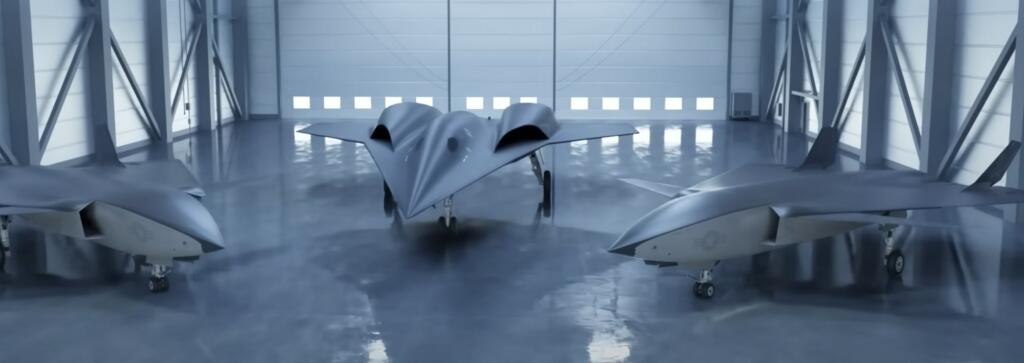GE Aerospace and Pratt & Whitney are in the prototyping phase for the Next Generation Adaptive Propulsion (NGAP) engine which will power the next generation air domination fighter (NGAD 6th generation figher). They both participated in the Adaptive Engine Transition Program (AETP) meant for the F-35 and are instead bringing that engine technology over to the new project. The advanced engine should allow for 20% more speed and 30% more range.
Above are renderings of what the next generation fighter might look like.


Above is the GE XA100 adaptive engine on the test stand. The 45,000 lbf (200 kN) thrust class engine is expected to be significantly more powerful and efficient than existing low-bypass turbofans.
Jet engines have been getting bigger for decades, so it is assumed that the new engines will be bigger.
The AETP engines—Pratt’s XA101 and GE’s XA100 fit in the F-35A but would need a redesign to fit the carrier-capable F-35C and short takeoff/vertical landing F-35B.
The military chose the F135 Engine Core Upgrade offered by Pratt & Whitney instead of the AETP. The ECU is a limited scope upgrade. It looks very similar to the existing motor in the F-35 but adds the latest design tools into the same supply base. The upgrade wouldn’t require any of the F-35’s interfaces to change and is limited to just the core of the engine. An upgraded F135 would be production cost neutral, despite having a budget of $200-250 million a year for the next several years. The initial cost of a brand-new adaptive engine would be about two and half times that of current the F135 and would add about $4 billion in production costs across the life of the program. Other estimates were the adaptive engine could cost more than $6 billion and force the military to buy roughly 70 fewer F35 fighters. The ECU upgrades will start to be added to operational jets sometime between 2030 and 2032 (if current timelines are met).
The ECU engines supports far higher cooling demands for new computers and upgraded sensors and electronics for block 4 F35s. Previously, they military wanted 15 kilowatts of cooling but with block 4 and block 5 the total cooling demands could end up being double or more. ECU is a lot of thermal management and cooling improvements and should allow for 80 kilowatts of cooling.
The AETP engines are 25% more fuel efficiency, 10% additional thrust, and significantly better thermal management by by using advanced materials and composites, ceramic matrix materials, thermal management improvements, and additive manufacturing. The new materials and technology for bleeding edge (“expensive”) increased capabilities will go into the next generation fighter and its new engine.

Brian Wang is a Futurist Thought Leader and a popular Science blogger with 1 million readers per month. His blog Nextbigfuture.com is ranked #1 Science News Blog. It covers many disruptive technology and trends including Space, Robotics, Artificial Intelligence, Medicine, Anti-aging Biotechnology, and Nanotechnology.
Known for identifying cutting edge technologies, he is currently a Co-Founder of a startup and fundraiser for high potential early-stage companies. He is the Head of Research for Allocations for deep technology investments and an Angel Investor at Space Angels.
A frequent speaker at corporations, he has been a TEDx speaker, a Singularity University speaker and guest at numerous interviews for radio and podcasts. He is open to public speaking and advising engagements.


We have leaders that are afraid to use our current weapons, future weapons are useless with no strength to use them.
We would face a much safer world when these come online if we had armed Ukraine as soon as Joe took office and encouraged them to destroy Russians on their home soil. Even the ancient F-16’s can be effective if not limited by timorous leadership.
We have no chance for a president with our safety in mind,Biden is weak,Harris is much worse , and hopefully, Donald is sulking in a Supermax.
Perhaps the solution is to look at rebuilding our own nation instead of destroying others.
obviously, there’s lack of education, so call Maverick 2050(?), but be aware, that’s effective, but ‘old habits’ considering ‘safety'(?),
yes, we learned, leadership and responsibility to ‘something’, like safety and rules (for a share of examples, but not all),
future weapons are useless, with no reconnaissance that’s trustable, otherwise one should call that spinning and manipulation
(and, for safety, maybe i’m wrong on that opinion 😉
“The initial cost of a brand-new adaptive engine would be about two & a half times that of current the F135 & would add about $4 billion in production costs across the life of the program … sometime between 2030 and 2032 (if current timelines are met).”
Now apply the normal 3x factor to DoD predictions of cost & schedule. And this is the cheap solution!!!